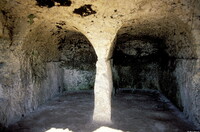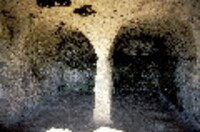| dc.coverage.spatial | Site: Syracuse, Sicily, Italy | en_US |
| dc.coverage.temporal | ca. 275-215 BCE (creation) | en_US |
| dc.creator | unknown (Greek (ancient)) | en_US |
| dc.date | -275--215 | en_US |
| dc.date.accessioned | 2013-03-27T15:38:16Z | |
| dc.date.available | 2013-03-27T15:38:16Z | |
| dc.date.issued | -275--215 | en_US |
| dc.identifier | 202596 | en_US |
| dc.identifier.other | archrefid: 1226 | en_US |
| dc.identifier.uri | http://hdl.handle.net/1721.3/110551 | |
| dc.description | View into two carved out grottos; Neapolis [Syracuse] was developed with a theatre, monumental altar 198 m long, stoas, nymphaeum and sacred precincts during the city's Hellenistic resurgence under the rule of Hieron II (reigned 275-215 BCE). The theatre is one of the largest in the Greek world (diam. 138 m) and influenced both Sicilian and Roman design. Source: Grove Art Online; http://www.groveart.com/ (accessed 2/3/2008) | en_US |
| dc.format.medium | limestone | en_US |
| dc.rights | © Scott Gilchrist, Archivision, Inc. | en_US |
| dc.subject | architectural exteriors | en_US |
| dc.subject | Performing arts | en_US |
| dc.subject | Hellenistic | en_US |
| dc.subject | Greek (ancient) | en_US |
| dc.title | Syracuse: Theater | en_US |
| dc.type | image | en_US |
| dc.rights.access | Licensed for educational and research use by the MIT community only | en_US |
| dc.identifier.vendorcode | 1A3-G-SI-T-C4 | en_US |
| vra.culturalContext | Greek (ancient) | en_US |
| vra.technique | construction (assembling) | en_US |
| vra.worktype | theater (building) | en_US |
| vra.worktype | excavation (site) | en_US |
| dc.contributor.display | unknown (Greek (ancient)) | en_US |



